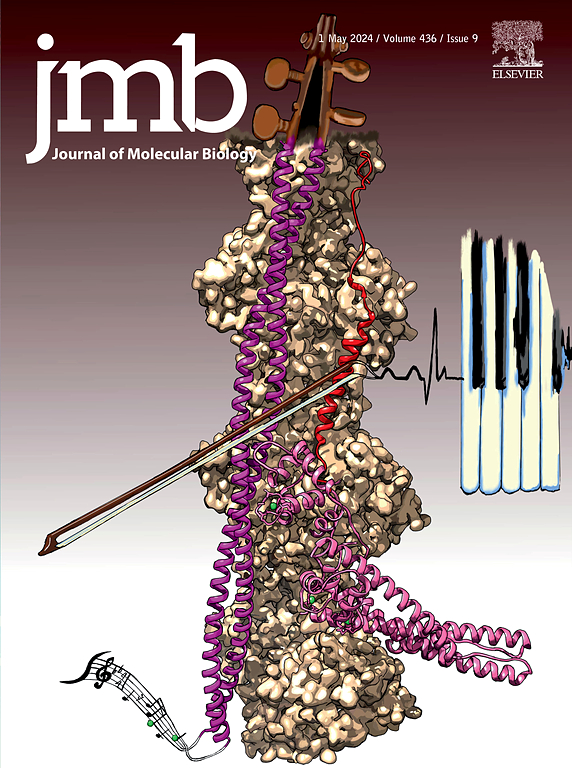变构抑制剂诱导的HIV-1整合酶聚合物的体外耐药突变的结构影响
IF 4.5
2区 生物学
Q1 BIOCHEMISTRY & MOLECULAR BIOLOGY
引用次数: 0
摘要
HIV-1整合酶(IN)被两类抗病毒药物靶向:整合酶链转移抑制剂(insis)结合到催化核心结构域(CCD)内的活性位点,以及变抗整合酶抑制剂(ALLINIs)结合到CCD二聚体界面。allini最初被设计用于破坏与细胞辅助因子LEDGF/p75的相互作用,但已经清楚allini主要通过促进异常整合酶聚合物的形成而起作用。allini通过稳定CCD二聚体和整合酶羧基末端结构域(CTD)之间的异位分子间相互作用来实现这一点,从而破坏病毒的成熟。之前,我们以4.4 Å的分辨率确定了与ALLINI GSK1264结合的全长HIV-1 IN的结构,揭示了其聚合机制。最近,我们以更高的分辨率报道了CCD, CTD和ALLINI BI-224436之间最小三元配合物的x射线晶体结构。在这项研究中,我们利用这一更高分辨率的信息改进了原来的4.4 Å结构,并报道了两个全长HIV-1 In的新结构,这些结构在CCD (Trp131Cys)或CTD (Asn222Lys)与原型ALLINI BI-D结合的4.5 Å处含有逃逸突变。这些结构揭示了与逃逸取代相关的三级组织的扰动,这与它们在体外形成异位allini诱导聚合物的能力降低有关。这些发现提示了ALLINI抗性的一般结构机制,并为改进ALLINI的设计提供了见解。本文章由计算机程序翻译,如有差异,请以英文原文为准。

Structural Impact of Ex Vivo Resistance Mutations on HIV-1 Integrase Polymers Induced by Allosteric Inhibitors
HIV-1 integrase (IN) is targeted by two classes of antivirals: integrase strand transfer inhibitors (INSTIs), which bind to the active site within the catalytic core domain (CCD), and allosteric integrase inhibitors (ALLINIs), which bind at the CCD dimer interface. ALLINIs were initially designed to disrupt interactions with the cellular cofactor LEDGF/p75, but it has become clear that ALLINIs primarily act by promoting formation of aberrant integrase polymers. The ALLINIs achieve this by stabilizing ectopic intermolecular interactions between the CCD dimer and the integrase carboxy-terminal domain (CTD), which disrupts viral maturation. Previously, we determined the structure of full-length HIV-1 IN bound to the ALLINI GSK1264 at 4.4 Å resolution, revealing its polymerization mechanism. More recently, we reported the X-ray crystal structure of a minimal ternary complex between CCD, CTD, and the ALLINI BI-224436 at a higher resolution. In this study, we improve the original 4.4 Å structure using this higher-resolution information and report two new structures of full-length HIV-1 IN harboring escape mutations in the CCD (Trp131Cys) or CTD (Asn222Lys) bound with the prototype ALLINI BI-D at 4.5 Å. These structures reveal perturbations to the tertiary organization associated with escape substitutions, which correlate with their reduced ability to form ectopic ALLINI-induced polymers in vitro. These findings suggest a general structural mechanism of ALLINI resistance and provide insights for the design of improved ALLINIs.
求助全文
通过发布文献求助,成功后即可免费获取论文全文。
去求助
来源期刊

Journal of Molecular Biology
生物-生化与分子生物学
CiteScore
11.30
自引率
1.80%
发文量
412
审稿时长
28 days
期刊介绍:
Journal of Molecular Biology (JMB) provides high quality, comprehensive and broad coverage in all areas of molecular biology. The journal publishes original scientific research papers that provide mechanistic and functional insights and report a significant advance to the field. The journal encourages the submission of multidisciplinary studies that use complementary experimental and computational approaches to address challenging biological questions.
Research areas include but are not limited to: Biomolecular interactions, signaling networks, systems biology; Cell cycle, cell growth, cell differentiation; Cell death, autophagy; Cell signaling and regulation; Chemical biology; Computational biology, in combination with experimental studies; DNA replication, repair, and recombination; Development, regenerative biology, mechanistic and functional studies of stem cells; Epigenetics, chromatin structure and function; Gene expression; Membrane processes, cell surface proteins and cell-cell interactions; Methodological advances, both experimental and theoretical, including databases; Microbiology, virology, and interactions with the host or environment; Microbiota mechanistic and functional studies; Nuclear organization; Post-translational modifications, proteomics; Processing and function of biologically important macromolecules and complexes; Molecular basis of disease; RNA processing, structure and functions of non-coding RNAs, transcription; Sorting, spatiotemporal organization, trafficking; Structural biology; Synthetic biology; Translation, protein folding, chaperones, protein degradation and quality control.
 求助内容:
求助内容: 应助结果提醒方式:
应助结果提醒方式:


